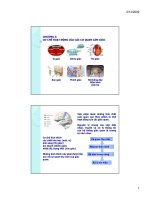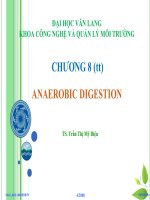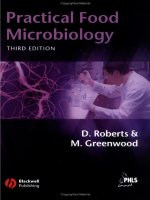ray - fundamental food microbiology 3e (crc, 2005)
Bạn đang xem bản rút gọn của tài liệu. Xem và tải ngay bản đầy đủ của tài liệu tại đây (3.64 MB, 625 trang )
CRC PRESS
Boca Raton London New York Washington, D.C.
Third Edition
FUNDAMENTAL
FOOD
MICROBIOLOGY
Bibek Ray
Cover Image:
Microscope with easy phase contrast, dark field, and bright light facilities (M 4002 D).
(Courtesy of Swift Instrument International, S.A.)
This book contains information obtained from authentic and highly regarded sources. Reprinted material
is quoted with permission, and sources are indicated. A wide variety of references are listed. Reasonable
efforts have been made to publish reliable data and information, but the author and the publisher cannot
assume responsibility for the validity of all materials or for the consequences of their use.
Neither this book nor any part may be reproduced or transmitted in any form or by any means, electronic
or mechanical, including photocopying, microfilming, and recording, or by any information storage or
retrieval system, without prior permission in writing from the publisher.
The consent of CRC Press LLC does not extend to copying for general distribution, for promotion, for
creating new works, or for resale. Specific permission must be obtained in writing from CRC Press LLC
for such copying.
Direct all inquiries to CRC Press LLC, 2000 N.W. Corporate Blvd., Boca Raton, Florida 33431.
Trademark Notice: Product or corporate names may be trademarks or registered trademarks, and are
used only for identification and explanation, without intent to infringe.
Visit the CRC Press Web site at www.crcpress.com
© 2004 by CRC Press LLC
No claim to original U.S. Government works
International Standard Book Number 0-8493-1610-3
Library of Congress Card Number 2003055738
Library of Congress Cataloging-in-Publication Data
Ray, Bibek
Fundamental food microbiology / Bibek Ray. 3rd ed.
p. cm.
Includes bibliographical references and index.
ISBN 0-8493-1610-3
1. Food Microbiology. I. Title
QR115.R39 2003
664d.001d579 dc22 2003055738
This edition published in the Taylor & Francis e-Library, 2005.
“To purchase your own copy of this or any of Taylor & Francis or Routledge’s
collection of thousands of eBooks please go to www.eBookstore.tandf.co.uk.”
ISBN 0-203-99825-1 Master e-book ISBN
Dedication
To my parents, Hem and Kiron, and my family
Preface to the Third Edition
In the third edition, substantial changes have been made in most of the chapters and
in their logical arrangement. In addition, one new chapter has been added. The
chapter on microbial stress has been written to include various manifestations of
bacteria under stress and their importance in food microbiology. As before, this book
is written primarily for students taking undergraduate food microbiology courses.
However, it can be used as a reference in other related courses in many disciplines
as well as by professionals engaged directly and indirectly in food-related areas. I
thank Elizabeth Smith for her excellent typing and editing in the preparation of the
manuscript. Finally, I thank my students for their helpful suggestions, especially for
the new materials included in this edition.
Preface to the First Edition
Between the time I first studied food microbiology as an undergraduate student and
now, the discipline has undergone a radical change. This change is well expressed
by Dr. David Mossel of the Netherlands in his letter published in ASM News (59,
493, 1993): from “no challenge in plate count and coliform scouting” to “linkage
of molecular biology to food safety (also food bioprocessing and food stability)
strategies — proclaim a new era in food microbiology.” This transition was necessary
to meet the changes that occurred in the food industry, especially in the U.S. and
other developed countries. The necessary knowledge, techniques, and expertise for
this transition were available. This book reflects this transition from the traditional
approach to an approach to meet the needs of those who are directly or indirectly
interested in food microbiology.
Introductory food microbiology is a required course for undergraduates majoring
in food science. In some form it is also taught in several other programs, such as
microbiology, public health, nutrition and dietetics, and veterinary science. For the
majority of food scientists, except those majoring in food microbiology, this single
course forms the basis of the study of microorganisms and their interactions to food.
Similarly, for the latter group, food microbiology is probably the only course that
provides information on the interaction of food and microorganisms. This book was
written with the major objective of relating interaction of microorganisms and food
in relation to food bioprocessing, food spoilage, and foodborne diseases. Thus, it
will be useful as a text in the introductory food microbiology courses taught under
various programs and disciplines. In addition, it will be a valuable reference for
those directly and indirectly involved in food and microbiology, including individuals
in academic institutions; research institutions; federal, state, and local government
agencies; food industries; food consultants; and even food lobbyists.
The subject matter is divided into seven sections. For undergraduate teaching,
the first six sections can be taught as a semester course; Section VII (Appendices)
can be used as advanced information for an undergraduate course which contains
materials that are either taught in other courses, such as advanced food microbiology,
or food safety courses and laboratory courses. Section I describes the history of food
microbiology, characteristics of microorganisms important in foods, their sources,
and significance. Section II deals with microbial growth and metabolism of food,
and the significance of microbial sublethal injury and bacterial sporulation in foods.
Section III explains the different beneficial uses of microorganisms, which include
starter cultures, bioprocessing, biopreservation, and probiotics. Section IV deals with
spoilage of foods by microorganisms and their enzymes and methods used to deter-
mine food spoilage. In addition, there is a chapter on problems and solutions of
some emerging spoilage bacteria in refrigerated foods. Section V deals with food-
borne pathogens associated with intoxication, infections, and toxicoinfections and
those considered to be opportunistic pathogens, as well as pathogenic parasites and
algae. In addition, a chapter has been included on emerging pathogens and a chapter
on indicators of pathogens. Section VI discusses different methods used to control
undesirable microorganisms for the safety and stability of food. A chapter on new
nonthermal methods and a chapter on the hurdle concept in food preservation are
included.
The materials in each chapter are arranged in logical, systematic, and concise
sequences. Tables, figures, and data have been used only when they are necessary
for better understanding. At the end of each chapter, a limited list of selected
references and suggested questions have been included. To reduce confusion, espe-
cially for those not familiar with the constant changes in microbial genera, three
first letters have been used to identify the genus of a species. The index has been
prepared carefully so that the materials in the text can be easily found.
I thank Mrs. Deb Rogers for her excellent performance in typing the manuscript.
Finally, I thank my students, who, over a period of the last 20 years, have suggested
what they would like to have in a food microbiology course. Their suggestions have
been followed while writing this text.
Preface to the Second Edition
It is gratifying to find that CRC Press showed interest in a second edition within 3
years of the initial publication of Fundamental Food Microbiology. As indicated
previously, this book was written primarily as a text for undergraduate food micro-
biology courses. The main objective was to provide basic and applied information
in as many areas as possible in about 500 pages. In the second edition, the materials
were carefully edited and new information included to keep it up to date. As before,
the second edition will be important not only to undergraduate students in a food
microbiology course, but also as a valuable reference book to graduate students in
the food science area, to individuals associated with the science, application, pro-
duction, and regulation of foods as related to microorganisms in academic institu-
tions, research institutions, and food-testing laboratories. In addition, short course
organizers, food consultants, food industries, food regulatory agencies, and food
science professionals will find this book valuable to understand and solve problems
associated with microbiological aspects of food. I thank Mrs. Deb Rogers for her
excellent typing and editing in the preparation of the manuscript and the students
in the food microbiology class for their helpful suggestions, including the new
material in the second edition.
The Author
Bibek Ray, Ph.D., was a professor of food microbiology in the Department of
Animal Science at the University of Wyoming, Laramie. Professor Ray earned B.S.
and M.S. degrees in veterinary science from the University of Calcutta and University
of Madras, in India, respectively. He received his Ph.D. in food science from the
University of Minnesota in 1970 and joined the faculty in the Department of Food
Science, North Carolina State University, and then the Department of Biology at
Shaw University, both at Raleigh. He joined the University of Wyoming in 1981.
There he expanded his research to intestinal beneficial bacteria, bacteriocins of
Gram-positive bacteria, and high hydrostatic pressure preservation of food along
with his previous research activities in the area of microbial sublethal injury. He
also taught courses in food microbiology, food fermentation, food safety, and a
course titled “Safety of Our Food” to nonscience undergraduates. His laboratory
was involved in extensive and thorough studies in both basic and applied areas of
the bacteriocin pediocin AcH from Pediococcus acidilactici H. In addition, his group
studied various aspects of bacteriocins produced by Lactococcus, Leuconostoc,
Lactobacillus, and Pediococcus as well as Bacillus and Staphylococcus spp. He
received research funding from the National Science Foundation, American Public
Health Association, National Live Stock and Meat Board, United States Department
of Agriculture, United States Army Research, North Atlantic Treaty Organization
(with Turkey) and Binational Agriculture Research Development Agency (with
Israel), Wyoming Development Fund, and the industry. Before retirement, he was
studying the combined effect of bacteriocins, ultrahigh hydrostatic pressure, and
pulse field electricity and sublethal injury on the destruction of microbial cells and
spores and its application in food preservation. In addition, Dr. Ray established
collaborative research programs with research institutes and universities in Turkey,
Israel, India, Indonesia, and France.
Professor Ray has published more than 100 research articles, reviews, book
chapters, proceedings articles, and popular articles on food microbiology. He has also
edited four books: Injured Index and Pathogenic Bacteria (1989) and Food Biopreser-
vatives of Microbial Origin (1992, with Dr. M.A. Daeschel), both published by CRC
Press, Boca Raton, Florida; Lactic Acid Bacteria: Current Advances in Metabolism,
Genetics, and Applications (1996, with Dr. Faruk Bozoglu), Springer, New York; and
Novel Processing and Control Technologies in the Food Industry (1999, with Dr.
Faruk Bozoglu and Tibor Deak), IOS Press, Washington, D.C. He was a member of
the American Society for Microbiology and the Institute of Food Technologists and
a Fellow of the American Academy of Microbiology. He also served on the editorial
boards of the Journal of Food Protection, Applied and Environmental Microbiology,
and the Indian Journal of Microbiology. In 1994, Professor Ray was awarded the
University of Wyoming Presidential Achievement Award in recognition of his excel-
lence in academic performance. He retired from the University of Wyoming in
September 2002. He is presently involved in developing a center to improve health,
education, and economic conditions of underprivileged people in his village of birth
in India and spends a great deal of his time in the village.
Table of Contents
Section I
Introduction to Microbes in Foods 1
Chapter 1
History and Development of Food Microbiology 3
Chapter 2
Characteristics of Predominant Microorganisms in Food 13
Chapter 3
Sources of Microorganisms in Foods 35
Chapter 4
Normal Microbiological Quality of Foods and its Significance 43
Section II
Microbial Growth Response in the Food Environment 55
Chapter 5
Microbial Growth Characteristics 57
Chapter 6
Factors Influencing Microbial Growth in Food 67
Chapter 7
Microbial Metabolism of Food Components 81
Chapter 8
Microbial Sporulation and Germination 93
Chapter 9
Microbial Stress Response in the Food Environment 103
Section III
Beneficial Uses of Microorganisms in Food 123
Chapter 10
Microorganisms Used in Food Fermentation 125
Chapter 11
Biochemistry of Some Beneficial Traits 137
Chapter 12
Genetics of Some Beneficial Traits 151
Chapter 13
Starter Cultures and Bacteriophages 173
Chapter 14
Microbiology of Fermented Food Production 183
Chapter 15
Intestinal Beneficial Bacteria 209
Chapter 16
Food Biopreservatives of Microbial Origin 225
Chapter 17
Food Ingredients and Enzymes of Microbial Origin 243
Section IV
Microbial Food Spoilage 255
Chapter 18
Important Factors in Microbial Food Spoilage 257
Chapter 19
Spoilage of Specific Food Groups 269
Chapter 20
New Food Spoilage Bacteria in Refrigerated Foods 289
Chapter 21
Food Spoilage by Microbial Enzymes 305
Chapter 22
Indicators of Microbial Food Spoilage 313
Section V
Microbial Foodborne Diseases 321
Chapter 23
Important Facts in Foodborne Diseases 323
Chapter 24
Foodborne Intoxications 343
Chapter 25
Foodborne Infections 359
Chapter 26
Foodborne Toxicoinfections 391
Chapter 27
Opportunistic Pathogens, Parasites, and Algal Toxins 405
Chapter 28
New and Emerging Foodborne Pathogens 417
Chapter 29
Indicators of Bacterial Pathogens 429
Section VI
Control of Microorganisms in Foods 439
Chapter 30
Control of Access (Cleaning and Sanitation) 441
Chapter 31
Control by Physical Removal 451
Chapter 32
Control by Heat 455
Chapter 33
Control by Low Temperature 467
Chapter 34
Control by Reduced A
w
475
Chapter 35
Control by Low pH and Organic Acids 483
Chapter 36
Control by Modified Atmosphere (or Reducing O–R Potential) 491
Chapter 37
Control by Antimicrobial Preservatives 497
Chapter 38
Control by Irradiation 507
Chapter 39
Control by Novel Processing Technologies 515
Chapter 40
Control by a Combination of Methods (Hurdle Concept) 529
Section VII
Appendices 535
Appendix A
Microbial Attachment to Food and Equipment Surfaces 537
Appendix B
Predictive Modeling of Microbial Growth in Food 541
Appendix C
Regulatory Agencies Monitoring Microbiological Safety of Foods
in the U.S. 545
Appendix D
Hazard Analysis Critical Control Points (HACCP) 549
Appendix E
Detection of Microorganisms in Food and Food Environment 555
Index 567
S
ECTION
I
Introduction to Microbes in Foods
Microorganisms are living entities of microscopic size and include bacteria, viruses,
yeasts and molds (together designated as fungi), algae, and protozoa. For a long
time, bacteria have been classified as procaryotes (cells without definite nuclei), and
the fungi, algae, and protozoa as eucaryotes (cells with nuclei); viruses do not have
regular cell structures and are classified separately. In the 1990s this classification
changed, and will be briefly mentioned in Chapter 2. Microorganisms are present
everywhere on Earth, including humans, animals, plants and other living creatures,
soil, water, and atmosphere, and they can multiply everywhere except in the atmo-
sphere. Together, their numbers far exceed all other living cells on this planet. They
were the first living cells to inhabit the Earth more than 3 billion years ago and since
then have played important roles, many of which are beneficial to other living
systems.
Among the microorganisms, some molds, yeasts, bacteria, and viruses have both
desirable and undesirable roles in our food. In this section, importance of microor-
ganisms in food, predominant microorganisms associated with food, sources from
which they get in the food, and microbiological quality of food under normal
conditions are presented in the following chapters:
Chapter 1: History and Development of Food Microbiology
Chapter 2: Characteristics of Predominant Microorganisms in Food
Chapter 3: Sources of Microorganisms in Food
Chapter 4: Normal Microbiological Quality of Foods and Its Significance
3
CHAPTER 1
History and Development of Food
Microbiology
CONTENTS
I. Introduction 3
II. Discovery of Microorganisms 3
III. Where Are They Coming From? 4
IV. What Are Their Functions? 5
V. Development of Early Food Microbiology (Before 1900 A.D.) 5
VI. Food Microbiology: Current Status 8
A. Food Fermentation/Probiotics 8
B. Food Spoilage 8
C. Foodborne Diseases 8
D. Miscellaneous 9
VII. Food Microbiology and Food Microbiologists 9
VIII. Conclusion 10
References 10
Questions 11
I. INTRODUCTION
Except for a few sterile foods, all foods harbor one or more types of microorganisms.
Some of them have desirable roles in food, such as in the production of naturally
fermented food, whereas others cause food spoilage and foodborne diseases. To
study the role of microorganisms in food and to control them when necessary, it is
important to isolate them in pure culture and study their morphological, physiolog-
ical, biochemical, and genetic characteristics. Some of the simplest techniques in
use today for these studies were developed over the last 300 years; a brief description
is included here.
4 FUNDAMENTAL FOOD MICROBIOLOGY
II. DISCOVERY OF MICROORGANISMS
The discovery of microorganisms
1–3
ran parallel with the invention and improvement
of the microscope. Around 1658, Athanasius Kircher reported that, using a micro-
scope, he had seen minute living worms in putrid meat and milk. The magnification
power of his microscope was so low that he could not have seen bacteria. In 1664,
Robert Hooke described the structure of molds. However, probably the first person
to see different types of microorganisms, especially bacteria, under a microscope
that probably did not have a magnification power above 300v, was Antony van
Leeuwenhoek. He observed bacteria in saliva, rainwater, vinegar, and other materials;
sketched the three morphological groups (spheroids or cocci, cylindrical rods or
bacilli, and spiral or spirilla); and also described some to be motile. He called them
animalcules, and between 1676 and 1683 he reported his observations to the newly
formed leading scientific organization, The Royal Society of London, where his
observations were read with fascination. As reasonably good microscopes were not
easily available at the time, other interested individuals and scientists during the
next 100 years only confirmed Leeuwenhoek's observations. In the 19th century, as
an outcome of the Industrial Revolution, improved microscopes became more easily
available, which stimulated many inquisitive minds to observe and describe the
creatures they discovered under a microscope. By 1838, Ehrenberg (who introduced
the term bacteria) had proposed at least 16 species in four genera and by 1875
Ferdinand Cohn had developed the preliminary classification system of bacteria.
Cohn also was the first to discover that some bacteria produced spores. Although,
like bacteria, the existence of submicroscopic viruses was recognized in the mid-
19th century, they were observed only after the invention of the electron microscope
in the 1940s.
III. WHERE ARE THEY COMING FROM?
Following Leeuwenhoek's discovery, although there were no bursts of activity, some
scientific minds were curious to determine from where the animalcules, observed
to be present in many different objects, were emanating.
1–3
Society had just emerged
from the Renaissance period, and science, known as experimental philosophy, was
in its infancy. The theory of spontaneous generation, i.e., the generation of some
form of life from nonliving objects, had many powerful followers among the edu-
cated and elite classes. Since the time of the Greeks, the emergence of maggots
from dead bodies and spoiled flesh was thought to be due to spontaneous generation.
However, ca. 1665, Redi disproved that theory by showing that the maggots in
spoiled meat and fish could only appear if flies were allowed to contaminate them.
The advocates of the spontaneous generation theory argued that the animalcules
could not regenerate by themselves (biogenesis), but they were present in different
things only through abiogenesis (spontaneous generation). In 1749, Turbevill
Needham showed that boiled meat and meat broth, following storage in covered
flasks, could have the presence of animalcules within a short time. This was used
to prove the appearance of these animalcules by spontaneous generation. Lazzaro
HISTORY AND DEVELOPMENT OF FOOD MICROBIOLOGY 5
\
Spallanzani (1765) showed that boiling the meat infusion in broth in a flask and
sealing the flask immediately prevented the appearance of these microscopic organ-
isms, thereby disproving Needham's theory.
This was the time when Antoine Laurent Lavoisier and his coworkers showed
the need of oxygen for life. The believers of abiogenesis rejected Spallanzani's
observation, suggesting that there was not enough vital force (oxygen) present in
the sealed flask for animalcules to appear through spontaneous generation. Later,
Schulze (1830, by passing air through acid), Theodore Schwann (1838, by passing
air through red-hot tubes), and Schröeder (1854, by passing air through cotton)
showed that bacteria failed to appear in boiled meat infusion even in the presence
of air. Finally, in 1861, Louis Pasteur demonstrated that, in boiled infusion, bacteria
could grow only if the infusions were contaminated with bacteria carried by dust
particles in air.
1,4
His careful and controlled studies proved that bacteria were able
to reproduce (biogenesis) and life could not originate by spontaneous generation.
John Tyndall, in 1870, showed that boiled infusion could be stored in dust-free air
in a box without microbial growth.
IV. WHAT ARE THEIR FUNCTIONS?
The involvement of invisible organisms in many diseases in humans was suspected
as early as the 13th century by Roger Bacon. In the 16th century, Girolamo Fracas-
toro of Verona suggested that many human diseases were transmitted from person
to person by small creatures. This was also indicated by Kircher in 1658. In 1762,
von Plenciz of Vienna suggested that different invisible organisms were responsible
for different diseases. Theodore Schwann (1837) and Hermann Helmholtz (1843)
proposed that putrefaction and fermentation were connected with the presence of
the organisms derived from air. Finally, Pasteur, in 1875, showed that wine fermen-
tation from grapes and souring of wine were caused by microorganisms. He also
proved that spoilage of meat and milk was associated with the growth of microor-
ganisms. Later, he showed the association of microorganisms with several diseases
in humans, cattle, and sheep, and he also developed vaccines against a few human
and animal diseases caused by microorganisms, including rabies. Robert Koch, in
Germany (in the 1880s and 1890s), isolated pure cultures of bacteria responsible
for anthrax, cholera, and tuberculosis. He also developed the famous Koch's postu-
lates to associate a specific bacterium as a causative agent for a specific disease.
Along with his associates, he also developed techniques of agar plating methods to
isolate bacteria in pure cultures and to determine microbial numbers in a sample,
the Petri dish (by Petri in his laboratory), staining methods for better microscopic
observation of bacteria, and the use of steam to sterilize materials to grow bacteria.
1,5
With time, the importance of microorganisms in human and animal diseases,
soil fertility, plant diseases, fermentation, food spoilage and foodborne diseases, and
other areas was recognized, and microbiology was developed as a specific discipline.
Later, it was divided into several subdisciplines, such as medical microbiology, soil
microbiology, plant pathology, and food microbiology.
6 FUNDAMENTAL FOOD MICROBIOLOGY
V. DEVELOPMENT OF EARLY FOOD MICROBIOLOGY
(BEFORE 1900 A.D.)
It is logical to comprehend that our early Homo ancestors, the hunters and gatherers,
were aware of food spoilage and foodborne diseases. Even without any perception
of the causative agents, they used ice and fire to preserve foods and make them safe.
Around 8000 B.C., as agriculture and animal husbandry were adopted by the early
civilizations, food supply, especially agricultural produce, became available in abun-
dance during the growing seasons. Preservation of foods became important for
uniform supply of food around the year. Between 8000 and 1000 B.C., many food
preservation methods such as drying, cooking, baking, smoking, salting, sugaring
(with honey), low-temperature storage (in ice), storage without air (in pits), fermen-
tation (with fruits, grains, and milk), pickling, and spicing were used, probably
mainly to reduce spoilage. However, one cannot be sure whether the society at that
time recognized the implications of diseases transmitted through food. In the later
periods, however, the scriptural injunctions laid by many religions suggest that the
societies recognized an association of diseases with some foods. Some of the reg-
ulations, such as not eating meat from a diseased animal or an animal killed by a
scavenger, or not eating a food that appeared unnatural or had been handled by an
unclean person, were developed to safeguard the health of citizens against foodborne
diseases. Fermentation was used extensively by many societies not only to preserve
foods but also as a method to produce various types of desirable foods from milk,
meat, fish, eggs, grains, fruits, and vegetables.
Following the discovery of the ubiquitous existence of microorganisms (mainly
bacteria and yeasts) by Leeuwenhoek around the 1670s, some individuals started
associating the possible role of these organisms with food spoilage, food fermenta-
tion, and foodborne diseases. The major developments of ideas on the possible roles
of microorganisms in foods and their scientific proof were initiated by Pasteur in
the 1870s, followed by many other scientists before the end of the 19th century.
This paved the way for the establishment of early food microbiology in the 20th
century. Some of the major developments in the 19th century are briefly listed
here.
1,6,7
Food Fermentation
1822 C.J. Person named the microscopic organism found on the surface of wine
during vinegar production as Mycoderma mesentericum. Pasteur in 1868
proved that this organism was associated with the conversion of alcohol to
acetic acid and named it Mycoderma aceti. In 1898, Martinus Beijerinck
renamed it Acetobacter aceti.
1837 Theodor Schwann named the organism involved in sugar fermentation as
Saccharomyces (sugar fungus).
1838 Charles Cogniard-Latour suggested that growth of yeasts was associated with
alcohol fermentation.
1860 Louis Pasteur showed that fermentation of lactic acid and alcohol from sugar
was the result of growth of specific bacteria and yeasts, respectively.
1883 Emil Christian Hansen used pure cultures of yeasts to ferment beer.
HISTORY AND DEVELOPMENT OF FOOD MICROBIOLOGY 7
\
Food Spoilage
1804 Francois Nicolas Appert developed methods to preserve foods in sealed glass
bottles by heat in boiling water. He credited this process to Lazzaro
Spallanzani (1765), who first used the method to disprove the spontaneous
generation theory.
1819 Peter Durand developed canning preservation of foods in steel cans. Charles
Mitchell introduced tin lining of metal cans in 1839.
1870 L. Pasteur recommended heating of wine at 145rF (62.7°C) for 30 min to
destroy souring bacteria. F. Soxhlet advanced boiling of milk for 35 min to kill
contaminated bacteria. Later, this method was modified and named
pasteurization, and used to kill mainly vegetative pathogens and many
spoilage bacteria.
1895 Harry Russell showed that gaseous swelling with bad odors in canned peas
was due to growth of heat-resistant bacteria (spores).
Foodborne Diseases
1820 Justin Kerner described food poisoning from eating blood sausage (due to
botulism). Fatal disease from eating blood sausage was recognized as early
as A.D. 900.
1849 John Snow suggested the spread of cholera through drinking water
contaminated with sewage. In 1854, Filippo Facini named the cholera bacilli
as Vibrio cholera, which was isolated in pure form by Robert Koch in 1884.
1856 William Budd suggested that water contamination with feces from infected
person spread typhoid fever and advocated the use of chlorine in water supply
to overcome the problem. In 1800, G. de Morveau and W. Cruikshank
advocated the use of chlorine to sanitize potable water.
1885 Theodor Escherich isolated Bacterium coli (later named Escherichia coli) from
the feces and suggested that some strains were associated with infant
diarrhea.
1888 A.A. Gartner isolated Bacterium (later Salmonella) enteritidis from the organs
of a diseased man as well as from the meat the man ate. In 1896, Marie von
Ermengem proved that Salmonella enteritidis caused a fatal disease in
humans who consumed contaminated sausage.
1894 J. Denys associated pyogenic Staphylococcus with death of a person who ate
meat prepared from a diseased cow.
1895 Marie von Ermengem isolated Bacillus botulinus (Clostridium botulinum) from
contaminated meat and proved that it caused botulism.
Microbiology Techniques
1854 Heinrich Schröder and Theodore von Dusch used cotton to close tubes and
flasks to prevent microbial contamination in heated culture broths.
1876 Car Weigert used methylene blue (a synthetic dye) to stain bacteria in
aqueous suspensions.
1877 Ferdinand Cohn showed heat resistance of Bacillus subtilis endospores.
1878 Joseph Lister isolated Streptococcus (now Lactococcus) lactis in pure
culture by serial dilution from sour milk.
1880s Robert Koch and his associates introduced many important methods that
are used in all branches of microbiology, such as solid media (first gelatin,
then agar) to purify and enumerate bacteria, Petri dish, flagellar staining,
steam sterilization of media above 100rC, and photography of cells and
spores.
1884 Hans Christian Gram developed Gram staining of bacterial cells.
8 FUNDAMENTAL FOOD MICROBIOLOGY
VI. FOOD MICROBIOLOGY: CURRENT STATUS
In the early 20th century, studies continued to understand the association and impor-
tance of microorganisms, especially pathogenic bacteria in food. Specific methods
were developed for their isolation and identification. The importance of sanitation
in the handling of food to reduce contamination by microorganisms was recognized.
Specific methods were studied to prevent growth as well as to destroy the spoilage
and pathogenic bacteria. There was also some interest to isolate beneficial bacteria
associated with food fermentation, especially dairy fermentation, and study their
characteristics. However, after the 1950s, food microbiology entered a new era.
Availability of basic information on the physiological, biochemical, and biological
characteristics of diverse types of food, microbial interactions in food environments
and microbial physiology, biochemistry, genetics, and immunology has helped open
new frontiers in food microbiology. Among these are:
1,6–8
A. Food Fermentation/Probiotics
• Development of strains with desirable metabolic activities by genetic transfer
among strains
• Development of bacteriophage-resistant lactic acid bacteria
• Metabolic engineering of strains for overproduction of desirable metabolites
• Development of methods to use lactic acid bacteria to deliver immunity proteins
• Sequencing genomes of important lactic acid bacteria and bacteriophages for
better understanding of their characteristics
• Food biopreservation with desirable bacteria and their antimicrobial metabolites
• Understanding of important characteristics of probiotic bacteria and development
of desirable strains
• Effective methods to produce starter cultures for direct use in food processing
B. Food Spoilage
• Identification and control of new spoilage bacteria associated with the current
changes in food processing and preservation methods
• Spoilage due to bacterial enzymes of frozen and refrigerated foods with extended
shelf life
• Development of molecular methods (nanotechnology) to identify metabolites of
spoilage bacteria and predict potential shelf life of foods
• Importance of environmental stress on the resistance of spoilage bacteria to anti-
microbial preservatives
C. Foodborne Diseases
• Methods to detect emerging foodborne pathogenic bacteria from contaminated
foods
• Application of molecular biology techniques (nanotechnology) for rapid detection
of pathogenic bacteria in food and environment
• Effective detection and control methods of foodborne pathogenic viruses
• Transmission potentials of prion diseases from food animals to humans









